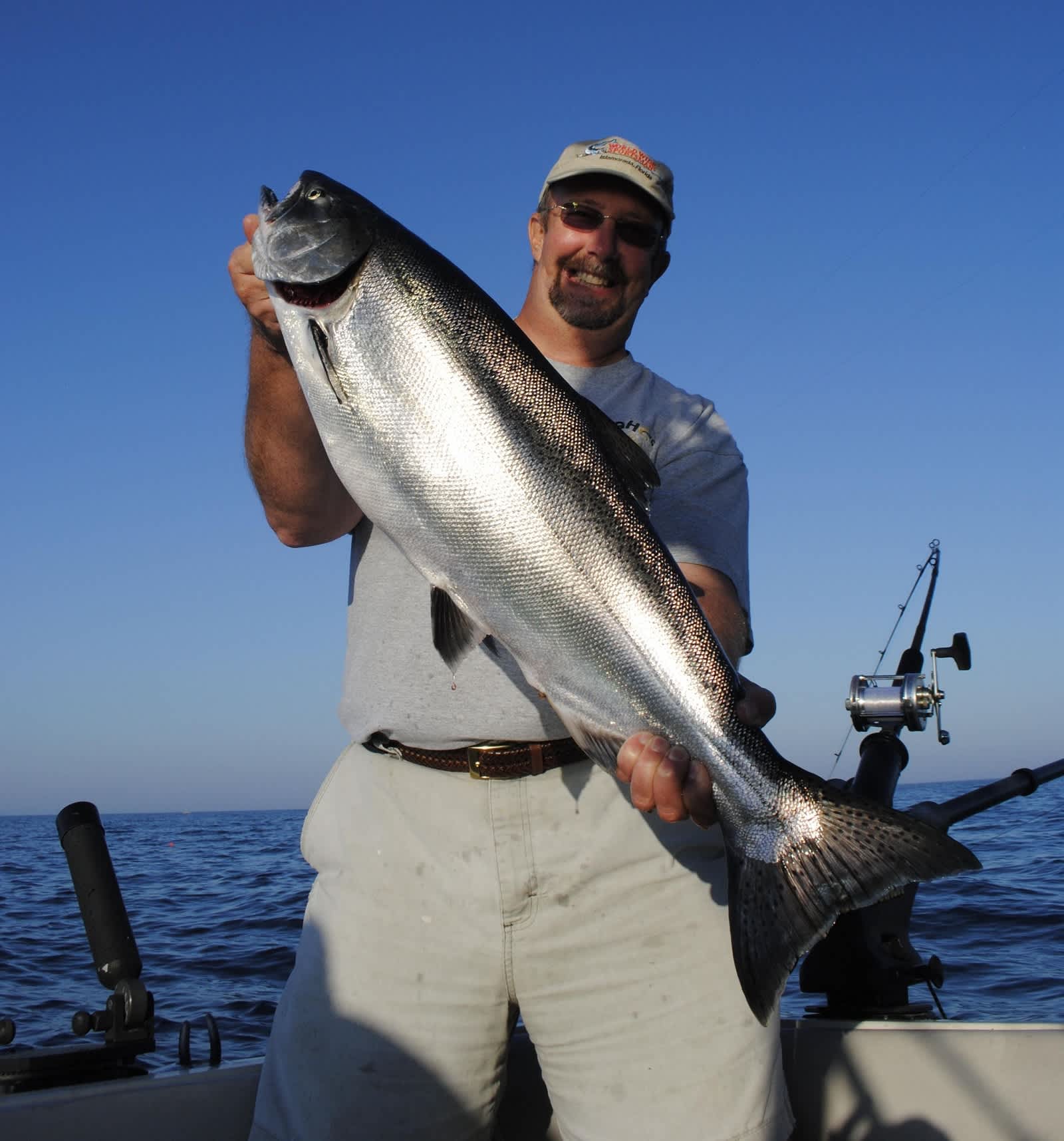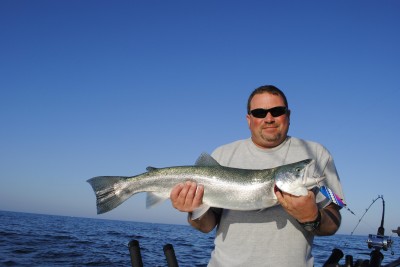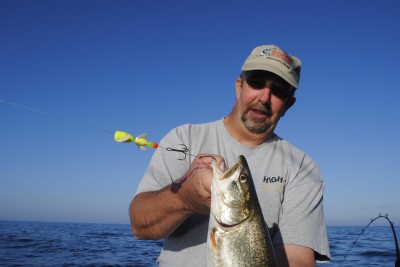Summertime Trolling on Lake Michigan
Bob Gwizdz 08.06.13

Every fishing trip is different and that’s especially so in the Great Lakes, where changing weather patterns and winds have a much bigger impact than they do on inland waters. Things change quickly on the big water and that much became apparent when I joined up with Don Carlsen and his buddies the other day on Lake Michigan.
Carlsen started out just where he’d left them two days earlier (when he and a couple of his pals boxed 15 fish), in 70 feet of water on a westward troll. But the changing winds had warmed the water dramatically and it didn’t take long for Carlsen to acknowledge the difference.
“We had a triple on in the dark the other day,” he said, as the sun poked out behind us.
It was bumpy. The wind, though it calmed as the morning wore on, had blown pretty hard all night. It took quite a while to find the 50-degree (or less) water that Carlsen was looking for.
We were in 110 feet of water before a fish hit, when a downrigger went off, but the king salmon shook the spoon before we could bring it to net. Still, it was the start of some of something; we had four more strikes within the next 30 minutes as we continued on our westward troll.

Only two of the biters, a nice king in the 15-pound range and a smaller guy (who also turned out to be a mature male when he cleaned him), saw the net. The fish can come on spoons off a downrigger (56 feet down) and a 10-color lead-core. Both were deeper than Carlsen had even caught a fish the last time out, when all his fish came from 30 feet down or less–high in the water column. Obviously, the wind had delivered a layer of warm water near the surface.
We hit a lull and went more than an hour without a strike. But we broke out of it with a fine steelhead. The bright, silvery ‘head started a second rally–four hits within a 30-minute span–but we only added one more, a lake trout, to the box.
Then it was back in the doldrums.
Carlsen was making his twenty-first trip of the season. He’d boated 121 fish in the first 20.
“Last year at this time we were in the mid-300s,” said Carlsen, a retired teacher who’s been chasing salmon around since the mid-1970s.
And the difference, he said, was not surprising.
“Going back into my records, there’s only been a few times when we’ve had real good years back to back,” he said. “Last year was an exceptional year. It petered out in the end, but the weather was unusual last year. This year we had a more typical winter and we had that four-week lull, right on time.
“But it looks like it’s setting up to be a good fall.”
Our second lull lasted more than 90 minutes. Then it started again when a wire-diver rod went off and the fish peeled off-line like it was heading to the beach. A rigger went off and we landed the fish, a 17-pound Chinook, while the first fish was still a long way from finished. When it finally came to the net, you could see why; it was a fat 23-pounder (Carlsen’s largest of the season, so far) that made the 17 look ordinary.

Of course, 17s have been almost ordinary this summer. Although most skippers report catching fewer fish than last year, the kings have been running big.
It was another five-bite rally, but only one more saw the box, a steelhead, shiny as a new dime (and like the first, it never went airborne, rather unusual for big-water steelhead).
Carlsen reversed course and doubled back over the productive water–as he had after the previous two rallies–but it was for naught, just as it had been the previous two times. That’s a sign that the fish are moving around. Perhaps they were looking for their comfort zone.
We fished another hour or so without so much as a sniff. Carlsen tried all of his tricks: changing from spoons to dodgers and flies, putting out rigs with more lead-core line, adjusting the depth on his downriggers–but it didn’t do any good. At 11 a.m., we started pulling lines.
We went seven for 14; it was a lower catch-to-strike ratio than I’d typically witnessed with Carlsen, with whom I’ve been fishing a day or more each year for the better part of two decades. But what’s the old saying? Sometimes you eat the bear and sometimes the bear…
Still, a seven-fish count was better than Carlsen’s average this year (by one) and he likes the direction things are going. The best fishing of the year should be coming up in the weeks ahead.
“It’s a typical day,” Carlsen said as he piloted his rig back toward the port. “And looking back at my records, it’s been a typical year.”
For more information on Michigan fishing go to michigan.org. Click here to purchase a Michigan fishing license online.

